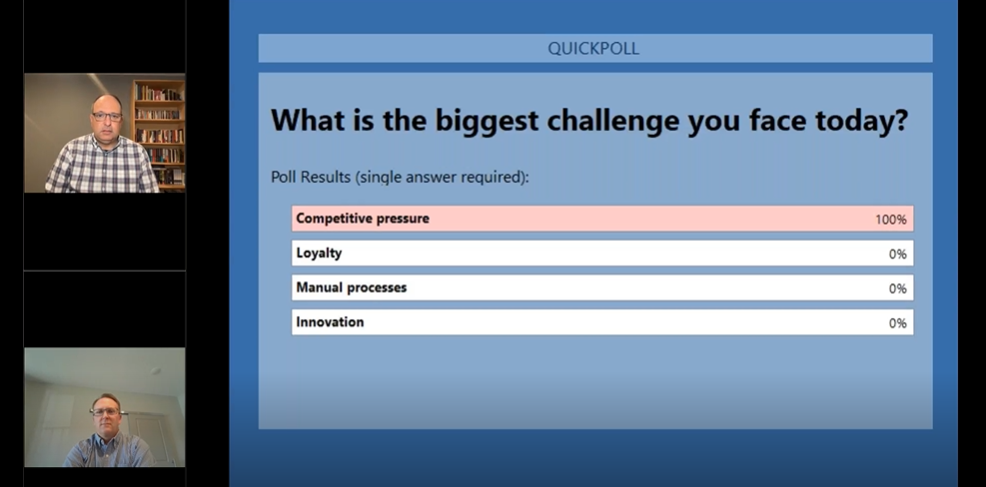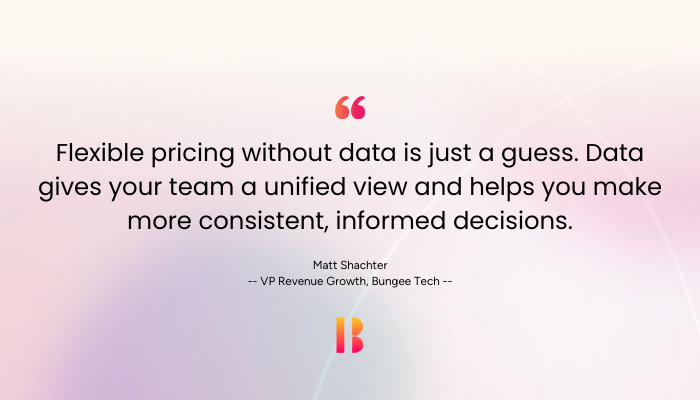Webinar Recap: Why Grocers Need Flexible Pricing
Reading Time: 16 Minutes
Grocery retailers face constant pricing pressure. Unlike discretionary purchases like TVs or clothing, groceries are essential, so shoppers want value every time they fill their carts. How can grocers deliver value while staying competitive and protecting margins?
Industry expert Scott Winburn joined Bungee Tech’s Matt Shachter to talk about the importance of a modern pricing approach in grocery retail during a recent NGA webinar.

The central message of the discussion: Traditional pricing methods can leave grocery retailers stuck in a daily grind. But a modern, data-driven approach helps you stay competitive, protects your margins, and delivers value to your shoppers and your bottom line.
A Day in the Life of a Pricing Leader
Matt Schachter shared, “I talk to grocery retailers every day, and one of the common sentiments is that a pricing leader’s day looks the same. But the factors around us—like inflation, competitive pressure, and changing products—aren’t the same. So, how can you expect to stay competitive if your approach doesn’t evolve?”
Scott Winburn agreed, adding, “People will always need to buy food, but the way they shop and the products they buy are evolving. Pricing strategies have to keep up.”
It’s easy to continue doing the things that made you successful in the past – especially when it comes to pricing.
It’s not easy to make quantifiable pricing changes. To make strategic changes, it takes a lot of effort – research, follow up, looking at the competition.
Refine vs. Redefine Pricing Approach
According to our webinar audience, competitive pressure is one the biggest challenges in grocery today. Everyone wants to know what their competitors are doing—how much they’re charging and what they’re promoting. But competitive pressure isn’t just about reacting to competition.

Winburn highlighted the importance of understanding your customer base, their expectations, and their perceptions. Then, shape pricing around their needs.
“Every grocer is competing for loyalty,” Winburn noted. “You can set yourself apart with pricing, but you need to understand who your core customers are and what’s important to them. It’s different for every consumer.”
As grocery shopping behaviors evolve, grocers should focus on building relationships with the once-a-week shoppers with full carts and the more frequent, smaller-basket buyers. Shoppers don’t fit into a one-size-fits-all approach.
One of the challenges with shopping behaviors is that you’re appealing to customers as young as 6 – who influence their mom – all the way up to 96. There’s a lot of generations – a lot of different shopping behaviors – a lot of different needs.
Price is the only factor that’s targeting every age group.
Shachter joked, “My mom was the first competitive intelligence solution. She knows the price of everything, everywhere!”
As a grocer, you manage price perception for each shopper. That’s challenging. Years ago, consumers relied heavily on promotions to make purchase decisions. Today, with the internet at their fingertips, shoppers expect fair prices without waiting for a sale. Winburn pointed out, “Consumers are smarter than ever about price, and they want what they want when they want it. It’s no longer about waiting for a discount—it’s about delivering value consistently.”
Other Common Pricing Challenges in Grocery
- Manual Processes: Spending hours manually product matching and adjusting prices is time-consuming and error prone.
- Disjointed Systems: Relying on disconnected systems hinders efficiency and makes it difficult to execute changes.
- Lack of Pricing Guardrails: Without clear guidelines and merchant processes, pricing decisions become inconsistent and lead to lost profits.
The way grocers navigate these complexities is driven by the availability of data and processes. The goal is to see the market fully. And act on your data.
In the News
-1- Dynamic Pricing / Price Gouging
There are a lot of articles about dynamic pricing, surge pricing, and price gouging in supermarkets and food stores. Grocers are not squeezing the most they can out of their shoppers. Yes, you want to protect their margins. Yes, you want to increase value.
Winburn explained, “Grocers have always done dynamic pricing in its most raw form. Think about it – weekly ad sales, where there’s seven days of dynamic pricing. Then, the 1- or 2-days sales, which are essentially dynamic pricing. Even the old Midnight Madness or Moonlight Madness sales – those go on for 6 hours – that’s it, and that’s dynamic pricing. It’s offering value during specific points in time during the day.”
-2- Shoppers Focus on Price
Article after article reminds us that price remains a huge priority for shoppers. They’re seeking value, that’s an expectation. In fact, 79% of shoppers say getting a good value is a top or high priority. We recommend learning about what consumers respond to, understanding key value items, and halo effect.
-3- Private Labels
And of course, private labels are a hot topic in grocery. More retailers are pushing private labels into the market which means grocers are competing at different price points. With private label, what’s the cheapest option in the market isn’t necessarily the best quality. Grocers need a compelling pricing program on private labels to be competitive in the marketplace.
Shachter noted, “Whether it’s a premium offer or a value-based offer, if you’re not comparing it to an equal-level private label product or national brand product, it skews your understanding. You want a true index of where your prices stand in the market. And so, your decision could change, or you could be sacrificing margin when you don’t need to, and maybe even alienating customers. It all comes down to understanding the competitive picture.”
Pricing Flexibility
“Pricing is nothing more than a ginormous math problem. That’s why being data-rich is great.” Winburn continued, “A lot of folks don’t have the time to dissect all the information day-in and day-out. They need action-ready approaches.”
The good news is: You have the ability to capture data to help you see the whole market. You have the ability to capture risks and opportunities.
At Bungee Tech, we talk about pricing flexibility or adaptable pricing a lot.
What it is:
Flexible pricing is the ability to use data and analytics to inform your pricing decisions at a strategic level. It’s the ability to understand how prices are affecting the bottom line.
What it is not:
Fluctuating demand and limited inventory.
“Flexible pricing without data is just a guess,” Schachter emphasized. “Data gives your team a unified view and helps you make more consistent, informed decisions.”
The grocery business requires flexible pricing strategies to adapt to changing consumer needs and competitive pressures. If you think about your prices as flexible or adaptable, it enables you to use data and technology to identify the best prices (for you and your customers).

Data-Rich Grocery Retailers
Accessing high-quality competitive intelligence data provides valuable insights into pricing, promotion, assortment, and availability. Then, level up your data by automating your pricing workflows. This combination saves time, reduces errors, and ensures consistency across your operations.
Grocery retailers are using data-driven insights to make informed decisions that align with pricing and assortment strategies and business goals.
“We talk about price optimization as a tool and as a practice that grocers use to maintain a flexible pricing approach and to be more competitive. It’s not just ‘I put data in’ and ‘prices spit out’. It’s about optimizing your operations – optimize handoffs and workflows – to prioritize our decision making,” Shachter pointed out.
Winburn added, “If you don’t have accuracy in data, you won’t have accuracy in results.”
What To Do Next
Adopt a modern, data-driven approach to pricing and break free from those limitations of traditional methods. By leveraging grocery market intelligence and automation, you can create a more flexible and effective pricing strategy that benefits both your business and your customers.
The Latest Insights – Straight to Your Inbox
Sign up for the Bungee Tech mailing list for actionable strategies, upcoming events, industry trends, and company news.














